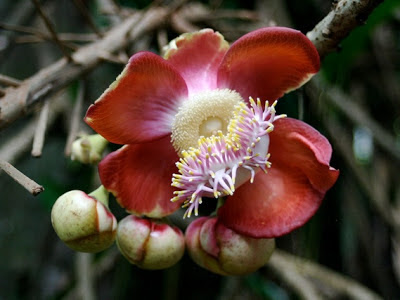When
the Buddha arrived in Kusinara and lay down between two Sal trees, they burst into flower out of
season and sprinkled their creamy-yellow petals over him. When Ananda expressed
amazement that the very trees were revering him, the Buddha said: “Ananda,
these Sal trees burst into flower out of season in homage to the Tathagata and
covered his body…But the monk or the nun, the lay man or the lay woman who lives
practicing the Dhamma properly and perfectly fulfils the Dhamma, he or she
honors, reveres and respects the Tathagata with the highest homage”
(D.II,137-8).
Being
Vesakha I thought it appropriate to say something about the Sal tree. A quick
perusal through Yahoo and Google Image will show an almost universal
misidentification of the Cannon-ball tree (Couroupita guianensis) with
the Sal tree (Shorea robusta). Wikipedia does the same. The
Cannon-ball tree is native of Brazil and gets its English name from the large
cannon-ball-shaped fruit that hang in bunched from its trunk. How did a
Brazilian tree get confused with an Indian tree? Well, first of all, this
confusion seems to have began with Sri Lankan Buddhists. The Sinhalese of course
have never seen a Sal tree which does not grow in tropical climates. They are
however, quite familiar with the Cannon-ball tree because it was introduced
into the Island by the Portuguese. Now the Cannon-ball tree not only has an extravagantly
beautiful pink and white blossom with an almost overpowering perfume, but also
in the heart of the flower is a small creamy-white nodule that looks exactly
like a little stupa. The rest followed automatically for the Sinhalese. The
Buddha died under a Sal and his remains were enshrined in a stupa + the
Cannon-ball tree has a stupa in its flower = the Cannon-ball tree must be the Sal
tree.
One can
well understand how simple Sinhalese peasants could make this harmless and
innocent mistake. But it says something about the influence (at least in some
areas) of Sri Lankan expatriate missionary monks that they have disseminated
this mistake so widely that now almost all Buddhists (outside India. Indian Buddhists know
better) take it as gospel. From one point of view this is, as I said, a
harmless, innocent mistake. From another point of view perhaps it is not. It
could be seen of as yet another example of Buddhist carelessness, of that “a myth is as good as a truth” attitude so common amongst Buddhists and
perhaps also of the Western Buddhists tendency to accept everything Asian
Buddhists tell them. So please! Let’s have no more confusion on this matter. As
the Buddha lay dying at Kusinara it was Sal blossoms that sprinkled down on
him, not cannon-balls!
Vesakha
blessings to all my readers.











5 comments:
Thanks for your post, Bhante. They're always so interesting.
To be showered in Sal blossoms certainly does sound more befitting of Buddha's final day, than to endure a bombardment of those canon-balls. Ananda would have had to bat them away or whip out a parasol.
«As the Buddha lay dying at Kusinara it was Sal blossoms that sprinkled down on him, not cannon-balls!»
This made my day! :-)
Better later than never, happy Vesak, Bhante!
I was also confused about the sal tree.
I am researching the presence of trees in the Therigatha and Theragatha and this led me to investigate the relationship of Buddha with trees.
Thank you very much for this entry, has cleared a little of my confusion
_/\_
Please correct tag and caption for the second picture of a dark pinkish flower, not Sal and clearly mislabeled by you as Sal on your photo tag! It should be labeled as A cannonball tree flower (Eugenia jambolana)as done for the following recent article:
Shedding light on Sal trees
By Ven. Shravasti Dhammika Thera
The Sunday Times Sri Lanka Wednesday, February 04, 2015
http://www.sundaytimes.lk/150201/plus/shedding-light-on-sal-trees-132451.html
Post a Comment